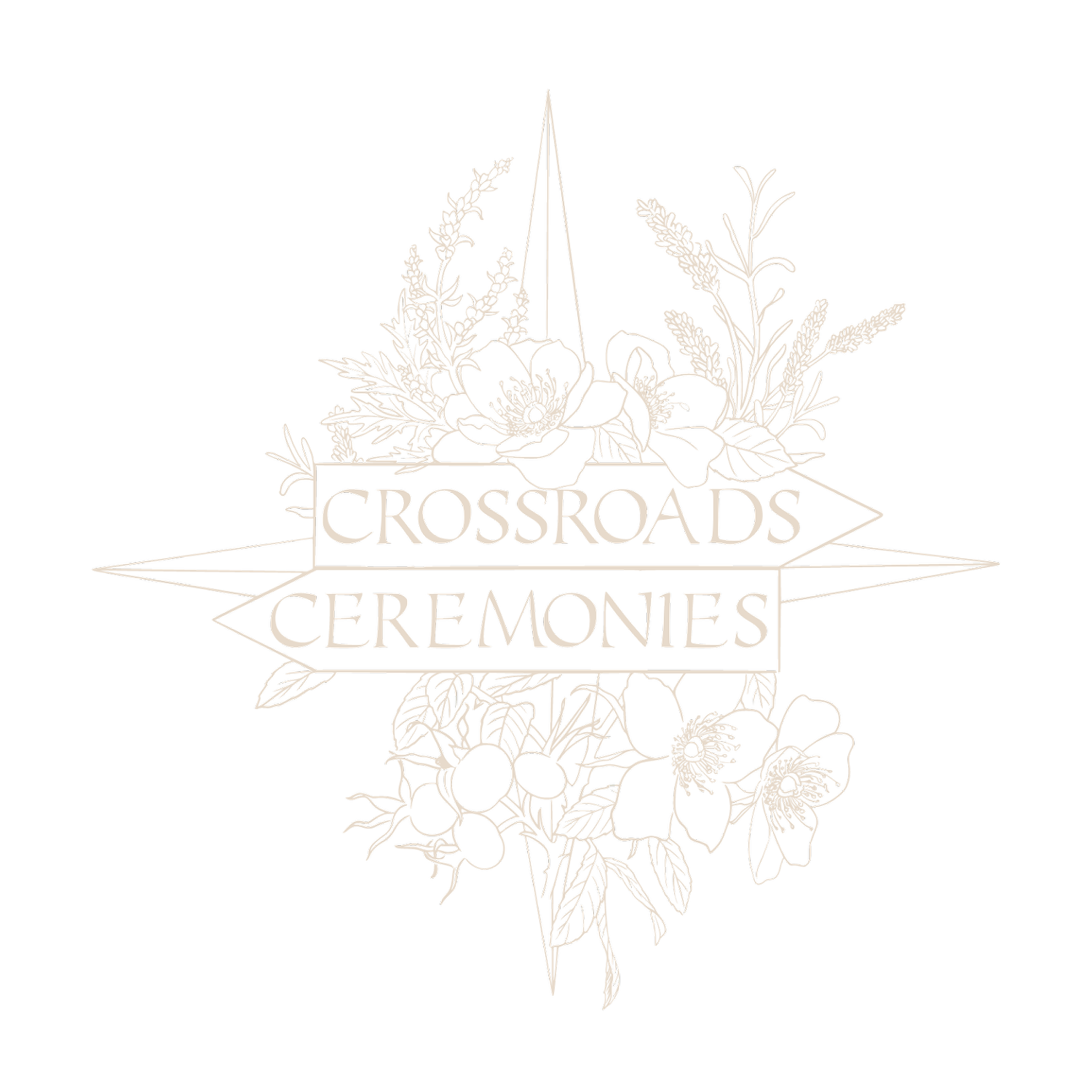Meet Me at the Crossroads
Two grassy paths meet in a misty meadow. A brown road sign points the way.
When I finished my training at the Celebrant Foundation and Institute, one of the questions before me was whether to give my new venture a name, or simply operate as “Rebecca Claborn, Funeral Celebrant.” At first, I was planning on the latter. Then one morning, the name “Crossroads Ceremonies” bobbed up into my mind from somewhere in the depths of my subconscious, and the hair standing up on the back of my neck told me my celebrant practice would have its own name after all.
In folklore, myth, and fairy tale, we arrive at the crossroads again and again. At dusk or dawn or midnight, in spring or autumn or the bleak midwinter, over and over we come to this place of choice, of decision, of directional change, and of intersection. All of these characteristics make the crossroads a potent metaphor for ceremony. After all, we come to ceremony when something major has changed in our life, or is about to change. And one of the primary purposes of ceremony is to create an intersection of ordinary and non-ordinary, a place where our everyday reality comes into contact with something altogether larger and more mysterious. Ceremony is a crossroads where the asphalt and concrete roads and sidewalks of our day-to-day lives intersect with the greater Road. You know the one: the Road of every legend and myth, the one that every hero sets off along at the beginning of their journey, the one that all those who came before us have walked, that will be walked by all who come after us, and that you yourself are walking right now.
Every so often, something happens in our lives that puts us in touch with the bigger story of what it means to be human. Life milestones, such as coming of age, marriage, or the birth of a child, are some such events. Death is another. When we encounter death, we are encountering the same mystery that all humans, everywhere, throughout history and around the world, have encountered. Our story intersects with theirs. We ask the same questions. We grieve, we cannot believe it, we can’t go on, we have to go on. And, somehow, we begin to try to comprehend the new shape of our lives, hollowed by an absence at the centre. This is where the funeral comes in.
From the time our species began to emerge, we have had death rites. Some archeological evidence suggests that our early Neanderthal cousins interred their dead with flowers, in a ritual-like behaviour that is instantly recognizable to us today. Throughout the centuries, we have gathered when someone in our community dies. Together, we have mourned, and supported those who were mourning. We have wept and sung, feasted and fasted, and given the bodies of our beloveds to the earth, the sea, the fire, and the sky. Marking the passage of someone we love from life into death is one of our oldest shared human experiences.
I believe that the rituals of death, whether we call them a funeral, a memorial, a celebration of life, a wake, or by any other name, are just as necessary to us now as they were to our ancient ancestors. Ritual speaks to the part of us that is older than language, that processes information through the body, in tactile action, image, and symbol. When we engage in ritual, we are using a means of communication that can bypass the endless thought-loops of our conscious mind, and instead engage directly with the heart. Ritual helps us begin to understand, on a level below consciousness, the loss we have experienced; to realize it, and to begin to integrate it into the new selves we will be going forward. Part of the purpose of funerary rites is to help those of us who are left behind recognize the transition we have experienced, to process it, and to begin to glimpse how we will move forward transformed. It is one of the hardest transformations most of us will ever undergo, which is why throughout human history we have gathered our communities around us at times of loss.
Historically, many of those gatherings have occurred at the crossroads, at the place where the roads that led to and from different communities converged, bringing people together. And so it is now, in the metaphorical crossroads of ceremony, where we can gather, exchange, mourn, laugh, and set forward in new directions - or in the same direction, but transformed.
If you are meeting me at the crossroads of life and death, you’ve already walked a hard road, and have a journey still ahead of you. It would be my honour to work with you, at this point of transition, to intentionally and consciously create a ceremony that will honour your dead, integrate the loss that has taken place, and offer an opportunity to take the first steps along the road of healing. If you are curious about working together to create such a ceremony, please reach out.


